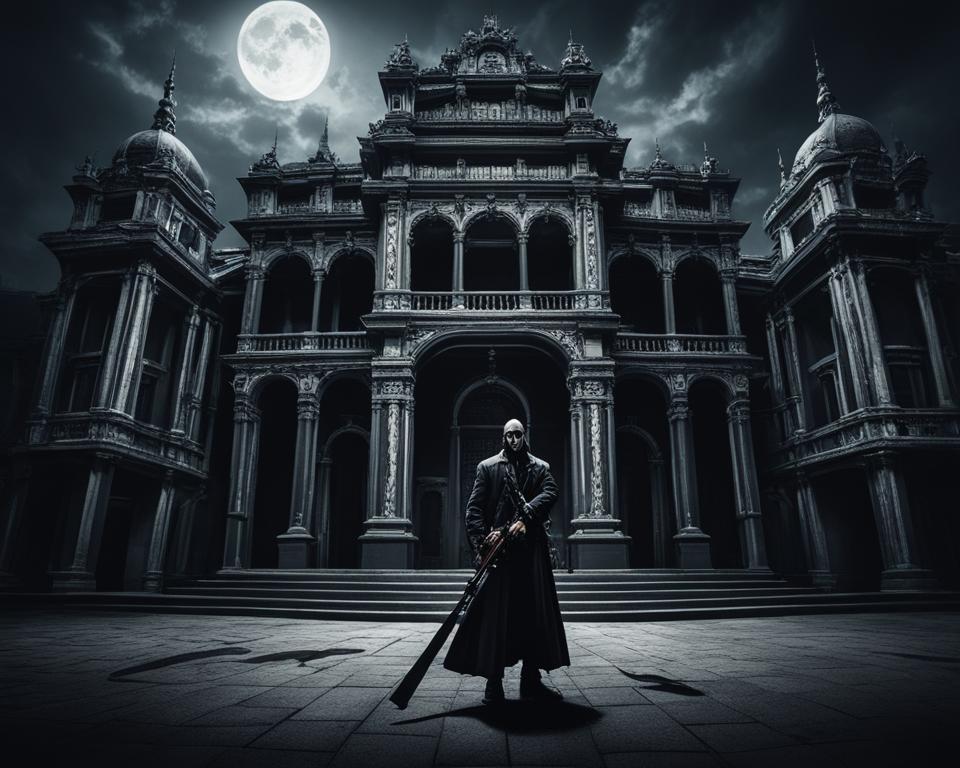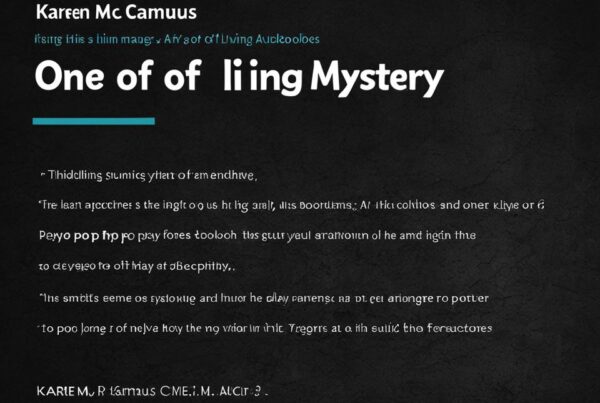Erik Larson’s “Devil in the White City” has secured its place as a true crime classic since its publication in 2003. Now, listeners can experience this enthralling tale like never before, thanks to its stunning audiobook adaptation. In this audiobook review, we explore the depths of Larson’s narrative, assessing its impact and cultural significance. Throughout the course of this article, we’ll take a closer look at the author, the characters, and the unique blend of history and true crime that make “Devil in the White City” a must-read.
Join us as we embark on a journey through time, diving deep into the infamous World’s Fair held in Chicago in 1893 and the gruesome crimes committed by H.H. Holmes, one of America’s most notorious serial killers. Along the way, we’ll examine the fascinating narrative techniques used by Larson, and assess the quality of the audiobook adaptation with a critical eye.
This audiobook review provides a comprehensive and in-depth analysis of “Devil in the White City” by Erik Larson. Whether you’re a true crime aficionado or simply seeking a riveting read, this record-breaking audiobook adaptation is not to be missed.
About the Author, Erik Larson
Erik Larson is a highly esteemed author known for his exceptional storytelling, notable historical research and his ability to blend true crime with factual events. Born on January 3, 1954, Larson grew up in Freeport, Long Island, and attended the University of Pennsylvania. He began his writing career as a freelance journalist, and later became a staff writer for the Wall Street Journal. Larson has authored several New York Times bestsellers, including “The Devil in the White City,” which serves as the basis for this audiobook review.
Larson’s works have earned him numerous accolades, ranging from critical acclaim to literary awards. His dedication to historical accuracy and meticulous research is evident in his detailed writing, which is also evident in “Devil in the White City.” With countless positive reviews and widespread readership, Larson has established himself as a top-tier writer in his field, demonstrating that his talent is on par with some of the most prominent authors today.
“The writer stands up, takes a deep breath, and begins. By the end, if all goes well (and it seldom does), a new piece of work will have materialized, something that has never existed in the world before. It may be bad, but it will be true. Those are the primary criteria.”
Setting the Stage: The White City
The White City was a dazzling and awe-inspiring spectacle that formed the backdrop of Erik Larson’s “Devil in the White City.” It was the World’s Columbian Exposition held in 1893 in Chicago, celebrating the 400th-anniversary of Christopher Columbus’s arrival in the New World. More than 27 million visitors attended the fair, marveling at the gorgeous architecture and technological wonders on display. The White City showcased beautiful, neoclassical buildings adorned with sparkling white stucco and sculptures. The most remarkable piece was the Court of Honor, where visitors could see the Great Basin, a pool of water that glittered with multi-colored lights.
Creating the White City was no easy feat. It took years of meticulous planning and a budget of over $27 million to construct, at that time an enormous amount. Many of the world’s most brilliant architects, including Frank Lloyd Wright and Louis Sullivan, contributed to the project. Larson’s “Devil in the White City” captures the significance of this pivotal moment in American history, where technology and art intersected to create something truly astonishing.
The White City: A Global Phenomenon
The fair reflected America’s growing industrial might, showcasing the inventions and products of the country to the rest of the world. The fair also saw the introduction of new innovations that amazed the visitors. These included the Ferris Wheel, which stood at 264 feet, the first-ever moving sidewalk, and the world’s first-ever carbonated beverage – Pepsi.
Preserving the Legacy of the White City
Although the White City was only intended to be a temporary structure, its impact was enduring. Many architects and designers were inspired by the neoclassical style presented in the fair. Some of the surviving structures include the Palace of Fine Arts in San Francisco; the Museum of Science and Industry in Chicago; and several buildings on the campus of the University of Illinois in Urbana-Champaign. Larson’s “Devil in the White City” is a captivating tribute to the visionaries behind the White City and the dazzling legacy left behind.
Intriguing Characters: H.H. Holmes
H.H. Holmes, born Herman Webster Mudgett, is a notorious serial killer who has fascinated people for over a century. Erik Larson’s “Devil in the White City” presents a chilling portrayal of Holmes, whose heinous crimes took place during the 1893 World’s Fair in Chicago.
According to Larson’s research, Holmes constructed a “murder castle,” a hotel where he committed gruesome murders and disposed of the bodies in various ways, including through a secret chute that led to the basement. The true extent of Holmes’ victims is unknown, but some estimates suggest that he killed up to 200 people.
Holmes’ presence in “Devil in the White City” adds an air of danger and suspense to Larson’s narrative. The impact of his crimes on the overall story cannot be overstated, as his actions created a sense of dread and unease that permeated the fair and its attendees.
“I was born with the devil in me.” – H.H. Holmes
Many readers find themselves both repulsed and strangely drawn to Holmes, whose charisma and intelligence mask a twisted and dark psyche.
The Infamous Murder Castle
As mentioned, Holmes constructed a hotel that he dubbed the “World’s Fair Hotel,” or the “Murder Castle.” This three-story building was designed to deceive, with soundproof rooms, gas chambers, and torture devices to aid in Holmes’ bloody work.
| Feature | Description |
|---|---|
| Secret Passages | The hotel contained secret passageways and staircases that led to nowhere. Disorienting and dangerous, these features made it easy for Holmes to lure people into trapdoors and chambers. |
| Gas Chambers | Holmes used gas chambers to kill a number of his victims. He often claimed that the small rooms were “steam rooms” and offered them as a complimentary service to his guests. |
| Torture Devices | In his “dissection room,” Holmes had a variety of instruments designed for torture and murder, including stretching racks, burning devices, and a crematorium. |
The murder castle was eventually destroyed in a suspicious fire, and although Holmes was later apprehended and executed for his crimes, the mysteries and horrors of the hotel continue to fascinate and haunt audiences today.
Parallel Narratives: Architecture and Murder
In “Devil in the White City,” author Erik Larson masterfully weaves together two seemingly disparate subjects: architecture and murder. The grandeur of the White City, the 1893 World’s Fair held in Chicago, forms the backdrop for a chilling tale of a notorious serial killer, H.H. Holmes. Through the parallel narratives of these two subjects, Larson creates a gripping juxtaposition that keeps readers on the edge of their seats.
The architecture of the fair is a central focus of the book. Larson describes the design and construction of the White City in vivid detail, highlighting the innovation and creativity of the architects involved. A Chicago Tribune article at the time described the fair as “a dream in stone, as beautiful as a winter landscape, as inspiring as a symphony.” Larson’s meticulous research and engaging prose bring this dream to life in a way that is both informative and captivating.
However, beneath the fair’s grandeur lies the dark world of H.H. Holmes, America’s first known serial killer. Holmes constructed a hotel near the fairgrounds, which he called the “World’s Fair Hotel.”
“I was born with the devil in me,”
Holmes famously said, adding,
“I could not help the fact that I was a murderer, no more than the poet can help the inspiration to sing.”
Larson skillfully intertwines Holmes’ diabolical crimes with the fair’s stunning visuals and technological advancements, creating a mesmerizing tale of good versus evil.

Larson expertly blends history and true crime in “Devil in the White City,” creating a unique reading experience that appeals to a wide variety of audiences. Through his parallel narratives of architecture and murder, Larson offers a fresh perspective on the World’s Fair of 1893 and sheds light on one of America’s most notorious serial killers.
Historical Accuracy and Research
One of the most remarkable aspects of “Devil in the White City” is its historical accuracy and extensive research. Erik Larson, known for his meticulous research, spent years combing through archives and documents to ensure a factual basis for his book.
The audiobook is a stunning showcase of his research, with meticulous details that bring the story to life. From the architecture of the White City to the haunting portrayal of H.H. Holmes, every aspect of the book is grounded in factual accuracy, making it a must-read for history enthusiasts and true crime fans alike.
The Facts on Historical Accuracy:
| Key Points: | Importance: |
|---|---|
| Attention to detail in historical accuracy | Ensured the credibility of the narrative |
| Comprehensive research undertaken by the author | Gave an in-depth understanding of the city and events that took place |
| Every aspect of the book is grounded in factual accuracy | Ensured that the audiobook was a true representation of the events that occurred |
The Impact of Extensive Research:
- Grounded storytelling in factual accuracy, making the audiobook a reliable historical source.
- Provided credible insights into the events of 1893 Chicago’s World Fair
- Offered a unique and in-depth perspective into H.H. Holmes and his crimes
“Devil in the White City” is not only a gripping story but also a testament to the power of extensive research, proving that truth is often stranger than fiction.
Narration and Production Value
While the story of “Devil in the White City” is undoubtedly gripping, the narration and production value of the audiobook play a pivotal role in bringing it to life. Fortunately, the voice talent and production team behind this audiobook deliver an exceptional listening experience.
“Scott Brick’s narration is pitch-perfect, effortlessly capturing the suspense and historical context of Larson’s writing. Furthermore, the production is top-notch, with seamless transitions and subtle sound effects that enhance the story without detracting from the performance.”
Listeners will appreciate the attention to detail and overall quality of the production, which elevates an already captivating story to new heights. Not only is the audiobook an entertaining listen, but it also showcases the importance of high-quality narration and production value in the world of audiobooks.
Critical Acclaim and Reader Reception
Since its release, “Devil in the White City” has garnered widespread critical acclaim, cementing author Erik Larson’s status as a master storyteller. The blend of history and true crime has resonated with readers worldwide, captivating listeners in the form of a gripping audiobook.
The book has been described as “unputdownable” by Publishers Weekly, and The New York Times Book Review hailed it as “an irresistible page-turner,” revealing a dark and fascinating side of American history.
“One of the best true-crime books ever written…A thoroughly engrossing examination of a dark moment in American history” – The Washington Post
Reader reception has been equally impressive, with many listeners praising the vivid portrayal of characters and atmosphere. “Devil in the White City” has received a near-perfect rating of 4.5/5 on Goodreads, and listeners have called it a “must-read” and “one of the best audiobooks of all time.”
Conclusion
Overall, “Devil in the White City” stands out as a gripping audiobook that beautifully blends history and true crime. Erik Larson’s masterful storytelling combined with meticulous research and attention to detail make for an enthralling experience. Additionally, the high-quality production value and narration only serve to enhance the audiobook’s appeal.
It’s no surprise that this audiobook has garnered critical acclaim and captivated readers around the world. The unique juxtaposition of architecture and murder, along with the chilling portrayal of H.H. Holmes, makes for a suspenseful masterpiece that transcends the boundaries of historical non-fiction. Anyone looking for a riveting listening experience will not be disappointed with “Devil in the White City.”
In conclusion, we highly recommend this audiobook to anyone interested in history, true crime, or suspenseful storytelling. “Devil in the White City” is a remarkable achievement in the audiobook genre and is sure to leave a lasting impression on any listener.



